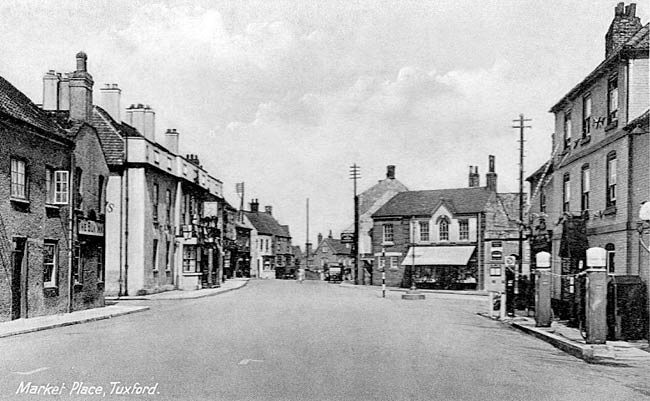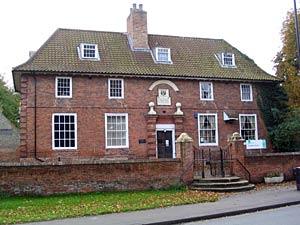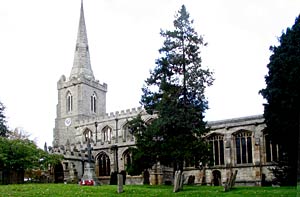< Previous | Contents | Next >
What God Hath Built

The Market Place, Tuxford, in the late 1930s.
TUXFORD. The Great North Road runs through this quiet old town where Scott's Jeanie Deans stayed the night on her weary journey to London.

The old grammar school, Tuxford, in 2006.
Most of its interests are within a stone's throw of the cross-roads and the old market square round which it clusters. The ancient church is near the 18th century hall, and opposite the hall is the Grammar School with the inscription over the doorway, "What God hath built let no man destroy." Though a school no longer, it is little changed since it was founded by Charles Read of Darlton, who made a fortune as a shipper 300 years ago. One of the rules he left for Tuxford School was that the boys should sweep out the schoolhouse in turn on Saturday afternoons or else be fined sixpence. The inn in the square (built after a fire in 1702, which destroyed much of the town) reminds us of the days when Tuxford was an important posting station for the half-dozen towns round it.
Looking over the town from the Retford road are three windmills whose work is done. At the other end, by the side of the Newark road, stands a stone pillar marking the grave of a rebel buried there in 1746.

Tuxford church in 2006.
The church outside looks even older than its years, for the soft Tuxford sandstone is badly weathered. A few feet of herringbone masonry in the west wall of the south aisle takes its story back perhaps to Saxon days, but the church is chiefly medieval. The tower and spire are 14th century except for an older window and doorway, and the spire, which has four dormers halfway up, has the singular appearance of being broached though it rises within a parapet. It is an interesting example of the passing of the broach with the coming of the parapet.
The 15th century south porch and a doorway a century older bring us to a nave crowned by a fine clerestory, its windows only a little shorter than the similar ones in the aisles: it was built in 1475 by Sir John Stanhope, whose arms are on the battlement. The nave arcades are 14th century, except for the 13th century pillars on the north side and the half-pillars on the south. The chancel was made new in the closing years of the 15th century, but its arch, part of its north arcade, and its piscina, are 700 years old. There is fine 15th century tracery in the modern chancel screen; the nave roof has some timbering and bosses of that time; and on the ends of the roof beams are ten painted angels resting on stone heads. The 17th century font has a fine pyramid cover and a suspended canopy, both richly carved, the canopy having the inscription "Francis Turner made this 1673."
The east end of the south aisle was the chantry of St Lawrence, and in its east window we see him in old black and yellow glass, holding his grid. On the wall below is a quaint stone sculpture of about 1400, showing the saint lying on the grid under a rich canopy, and figures of three men rather battered, one with the bellows having lost his head. The old piscina is still here, and resting on a bracket carved with a bearded face is part of a draped figure. Built into the wall of the modern north porch is a gravestone showing the head and shoulders of a priest recessed in a quatrefoil, a chalice below his praying hands.
The north chancel chapel was widened in the 18th century to be a burial-place for the Whites, lords of Tuxford for many generations. The alabaster figures of Sir John White of 1625 and his wife lie on a tomb, their heads resting on tasselled cushions, both without hands or feet but wearing beautiful ruffs. Sir John, with a pointed beard, is in armour; his lady's mantle and gown have exquisite borders, and she has a fine chain round her shoulders. Charles Lawrence White, mortally wounded in 1814 at Bayonne, has a white wall monument with a carving of his grave and those of three brother officers.
One of two ancient figures in the chapel is a cross-legged knight with a broken sword, his feet on a battered beast; the other is a slender woman in alabaster, wearing a long gown adorned with roses, her feet on two small dogs; one is biting the other's ears and the other his companion's paw.
Beautiful glass of our own day fills two chancel windows. In the east is a Te Deum window glowing softly with cherubs in the tracery, a choir of minstrel angels, Our Lord in Glory, and four fine figures of saints. The other, in memory of Armistice Day, shows Thomas Becket robed in red and gold, the Madonna and Child in blue and white, and Peter in brown and gold. The modern pulpit is richly carved with a border of vines, and figures of St Agnes, St Anne, and Our Lord on the Cross.
